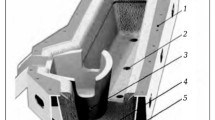Conclusions
Examination of the phenomenon of nozzle blockage, encountered during casting of aluminum-killed steel, resulted in the following conclusions:
-
1.
The mechanism of clogging is a complex process involving the precipitation of alumina in the bore of the nozzle augmented by dendritic growth of entrapped steel.
-
2.
At low aluminum concentrations (<0.01% Al soluble), the alumina branches were found to be embedded in a matrix of MnAlSi-oxides, while at higher concentrations (≥0.01% Al soluble) the matrix tended to disappear with the clog consisting only of alumina and frozen steel.
-
3.
Although the tendency for build-up to occur was found even at low aluminum concentrations, complete blockage of the nozzle was encountered only at concentrations ≥ 0.008% Al soluble.
-
4.
While reducing reoxidation of the steel in the tundish through complete shielding decreased the rate of clogging, it did not completely eliminate the problem.
-
5.
A new nozzle design with improved heat transfer characteristics eliminated blockage under strictly controlled operation. However, the stringent requirements for high tundish preheat ≥ 2450 °F) and a minimum steel temperature of 2800 °F, together with the unresolved problem of canting of the stream, are believed to impose serious limitations under actual plant conditions.
-
6.
The concept of a variable orifice for casting achieved by an oversized nozzle with stopper rod control represents a solution to the problem of nozzle blockage. However, application of this technique to the casting of high quality billets depends on the significance of the following: (a) the practicability of a shrouded tundish stream; (b) development of a control system to prevent large variations in casting rate: and (c) the effect of agglomerated alumina, washed out of the nozzle, on product quality.
Similar content being viewed by others
References
F. Tomsu and V. Dolezel: Steel Times, Sept. 9, 1966, pp. 344–346.
A. Bungeroth and E. Scheufele: Steel Times, Sept. 18, 1964, pp. 402–403.
B. Tarmann: Härterei-Technische Mitteilungen, 1962, Vol. 17, pp. 29–38.
Author information
Authors and Affiliations
Rights and permissions
About this article
Cite this article
Duderstadt, G.C., Iyengar, R.K. & Matesa, J.M. Tundish nozzle blockage in continuous casting. JOM 20, 89–94 (1968). https://doi.org/10.1007/BF03378699
Published:
Issue Date:
DOI: https://doi.org/10.1007/BF03378699




